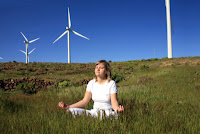By Kimaya Singh
Fear is an all encompassing emotion
and it goes by different names, all of which define the deep state of anxiety about something that
has yet to happen. Everyone has fear, uncertainty, panic, and anxiety. Much of
society suffers from phobias, panic attacks, life altering events, and extreme
anxiety. Therapy, anti-depressants, and anti-anxiety drugs are often given to
combat these feelings of fear.
The main concept of therapy is to teach people how to face these fears that seem to overwhelm them. Once the objective is achieved living a happier and more meaningful life is much easier. There are other alternatives to overcoming these fears. Some people are turning to Yoga training sessions to move beyond debilitating fear. Yogic methods allow the individual to focus on the inside. Fear is often a conditioned response; lessons learned in life from past experiences or things individuals were taught to fear.
Pranayama practice is the art of yogic breathing. This is a popular yoga technique that works well for reducing panic and anxiety attacks. One common symptom of a panic attack is shallow breaths that happen in the chest, this is an indication that the body has taken a fight or flight response to fear. A yoga breathing regimen is required, to slow the breathing down to a deeper and relaxed state.
The main concept of therapy is to teach people how to face these fears that seem to overwhelm them. Once the objective is achieved living a happier and more meaningful life is much easier. There are other alternatives to overcoming these fears. Some people are turning to Yoga training sessions to move beyond debilitating fear. Yogic methods allow the individual to focus on the inside. Fear is often a conditioned response; lessons learned in life from past experiences or things individuals were taught to fear.
Pranayama practice is the art of yogic breathing. This is a popular yoga technique that works well for reducing panic and anxiety attacks. One common symptom of a panic attack is shallow breaths that happen in the chest, this is an indication that the body has taken a fight or flight response to fear. A yoga breathing regimen is required, to slow the breathing down to a deeper and relaxed state.
A Medical Adjunct
Some states of fear are so deep that medical and professional counseling should be sought first. Yoga can help, but it can be most effective as an adjunct therapy. Although yogic methods differ in approach, they can easily be integrated into any form of therapy.
Yogic methodology teaches us to embrace the fear with practice and a trained mind. Embracing the fear is an important step in the process. When attention is brought to the fear, and the flight response is not active, the fear loses power. It becomes a learning process and an opportunity for self-growth.
Yoga training teaches us to ground ourselves to the earth and helps us stay focused on the now. Taking walks, diverting the mind, and connecting the feet to the earth can reduce anxiety. As a form of anxiety prevention, flowing asanas can also change our mindset.
Yogic methodology teaches us to embrace the fear with practice and a trained mind. Embracing the fear is an important step in the process. When attention is brought to the fear, and the flight response is not active, the fear loses power. It becomes a learning process and an opportunity for self-growth.
Yoga training teaches us to ground ourselves to the earth and helps us stay focused on the now. Taking walks, diverting the mind, and connecting the feet to the earth can reduce anxiety. As a form of anxiety prevention, flowing asanas can also change our mindset.
Possible Preventative Methods
.
Opening the eyes and looking around at nature can be surprisingly helpful. Simple things like a bird, squirrel or butterfly can bring one's state of mind out of fear and back to the present reality. A simple distraction from the flight impulse is often enough to snap someone back to reality.
Connect with the inner child, who accepts situations. Watch a comedy and have a belly laugh. Through these holistic methods, one can start to recondition one’s self and move beyond fear.
.
Opening the eyes and looking around at nature can be surprisingly helpful. Simple things like a bird, squirrel or butterfly can bring one's state of mind out of fear and back to the present reality. A simple distraction from the flight impulse is often enough to snap someone back to reality.
Connect with the inner child, who accepts situations. Watch a comedy and have a belly laugh. Through these holistic methods, one can start to recondition one’s self and move beyond fear.
© Copyright 2016 – Aura Wellness Center – Publications Division
Do you want to become a yoga instructor? See our selection of affordable meditation and 200 hour yoga teacher training intensive programs.











